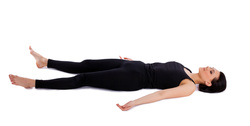|
|
Back to Blog
 Photo credit: Shutterstock Photo credit: Shutterstock By Lira Razak Picture this familiar scenario: you walk into yoga class, lie in savasana, or the corpse pose, close your eyes and as you try to let go of all the thoughts of the world in your mind to settle into the pose, more thoughts just keep streaming in like neon billboards against the darkness. You start taking in deep long breaths to calm your mind, but your thoughts linger. It takes a while to quieten your mind but just as you are about to settle into the pose comfortably – your yoga teacher walks in to start the class. The corpse pose is the one pose that is present in just about every yoga class, and done most willingly by everyone at the end of class as it is afterall, the pose of relaxation. At first glance, it appears to be one of the easiest pose to get into – you lie down on your back, feet mat width distance apart, toes turned out and relaxed, arms slightly away from your body and palms facing upward. With your shoulders relaxed downwards, facial muscles relaxed, you hear the voice of your instructor telling you to let your natural breathing take over, let your jaw relax, and not to partake in the thoughts that may come to your mind. Immediately a thought does come to your mind – maybe that cool drink you desperately want to take, or that thing with work that was bugging you before you came for yoga class and is now back in full-force as you try to get yourself into relaxation mode. On the other end of the spectrum as opposed to thoughts busily occupying your mind, as you get into relaxation mode – and this I have been guilty of in Yin class – without you even realising it, you start floating away into a dream sleep. Or you start daydreaming about something that your mind picked up on. During savasana, it is the delicate balance to stay present, to be able to let go, and yet still be aware, that makes it one of the most challenging poses in a person’s practice. Your mind has to be in that space between wakefulness and sleep, not focusing on thoughts and letting them pass as they come up, being conscious and present in the moment. When we do our yoga postures during our dynamic practice and our mind becomes busy with pushing ourselves, we lose track of our breathing and the benefit of the pose. In a similar manner for savasana, thinking, falling asleep or daydreaming during the pose cancels out its benefit as well as its intended purpose. In savasana, you let your natural breathing take over as you release any breathing techniques you had been using throughout the asana practice. As you let your natural breathing take over and breathing slows down, your mind mingles with your breathing and the sensations in the body. As we sink more into relaxation, we pick up on passing thoughts, memories, and feelings in the deep corners of our psyche. Inherent in the human nature is the natural instinct to react to these thoughts, memories and feelings. To think, to sleep or to daydream is the mind’s way of reacting to emotions that bubble up as your mind gets in touch with the sensations in your body. The key is to let these thoughts hover, to notice, and to let it pass so you arrive in the present moment. Every yoga posture has its intended purpose and benefit. When savasana is done as intended in its purpose, your mind is conscious, but you do not react to what comes in your mind, and instead surrender and let it pass through. When the instinctive efforts to react to these thoughts cease, accepting all the emotions as your sense of self is heightened, you have faced the challenging aspects of savasana. There is no definite time for a person to stay in the pose to achieve surrender into savasana. A person can stay in the pose for as long a time, or as short a time as needed. In a yoga class where practice is guided, it helps to listen to the yoga teacher’s instructions as he or she guides you into settling into the pose. For individual practitioners, a quiet room and comfortable surroundings may help with easing into the pose easier. In a world where we are rewarded for constantly being on the go and for the activities that we do, to instinctively react to things around us, being still and letting go is a great challenge and savasana, the corpse pose, is a perfect example of this. Republished with permission from www.intheloop.com.sg
0 Comments
Read More
|